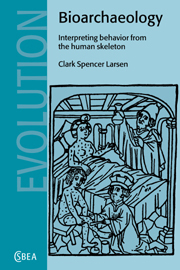Book contents
- Frontmatter
- Contents
- Acknowledgments
- 1 Introduction
- 2 Stress and deprivation during the years of growth and development and adulthood
- 3 Exposure to infectious pathogens
- 4 Injury and violent death
- 5 Activity patterns: 1. Articular and muscular modifications
- 6 Activity patterns: 2. Structural adaptation
- 7 Masticatory and nonmasticatory functions: craniofacial adaptation
- 8 Isotopic and elemental signatures of diet and nutrition
- 9 Historical dimensions of skeletal variation: tracing genetic relationships
- 10 Changes and challenges in bioarchaeology
- References
- General index
- Site index
6 - Activity patterns: 2. Structural adaptation
Published online by Cambridge University Press: 05 June 2012
- Frontmatter
- Contents
- Acknowledgments
- 1 Introduction
- 2 Stress and deprivation during the years of growth and development and adulthood
- 3 Exposure to infectious pathogens
- 4 Injury and violent death
- 5 Activity patterns: 1. Articular and muscular modifications
- 6 Activity patterns: 2. Structural adaptation
- 7 Masticatory and nonmasticatory functions: craniofacial adaptation
- 8 Isotopic and elemental signatures of diet and nutrition
- 9 Historical dimensions of skeletal variation: tracing genetic relationships
- 10 Changes and challenges in bioarchaeology
- References
- General index
- Site index
Summary
Bone form and function
Julius Wolff, a leading nineteenth century German anatomist and orthopedic surgeon, recognized the great sensitivity of bones to mechanical stimuli, especially with regard to their ability to adjust size and shape in response to external forces. Wolff concluded that ‘every particle of mature bone is very active. Such activity must appear in the external shape of the bones’ (1892:78). What he called the ‘law of bone remodelling’ – now known as Wolff's Law – simply states that bone tissue places itself in the direction of functional demand.
A great deal of evidence has accrued in support of Wolff's hypothesis, thus demonstrating the primacy of the mechanical environment in interpreting skeletal structural variation. Experimental and other research on bone remodeling is instrumental in identifying patterns of skeletal modification under different loading regimes (see Lanyon et al., 1982; Meade, 1989; Trinkaus et al., 1994). Using laboratory dogs, Chamay & Tschantz (1972) observed that the surgical removal of portions of radii resulted in the hypertrophy of ulnar diaphyses. The ulnar diaphyses increased in size by 31% after just 16 days and 60–100% at nine weeks. Similarly, Lanyon and coworkers (Goodship et al., 1979; Lanyon & Bourne, 1979) documented increased apposition of bone on the radius following ulnar osteotomies in pigs and sheep. Nonsurgical load alterations have also resulted in changes in bone mass.
- Type
- Chapter
- Information
- BioarchaeologyInterpreting Behavior from the Human Skeleton, pp. 195 - 225Publisher: Cambridge University PressPrint publication year: 1997
- 2
- Cited by



